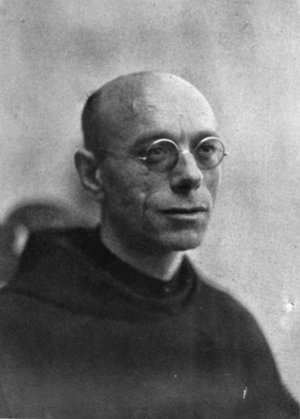Justo Pérez de Urbel facts for kids
Quick facts for kids
Fray Justo Pérez de Urbel
|
|
|---|---|
 |
|
| In office 16 March 1942 – 1967 |
|
| Personal details | |
| Born |
Justo Pérez Santiago
August 7, 1895 Pedrosa de Río Úrbel, Burgos, Spain |
| Died | 1979 (aged 83–84) Cuelgamuros, Madrid, Spain |
| Political party | FET y de las JONS |
| Occupation | Benedictine clergyman, medievalist |
Justo Pérez Santiago (born August 7, 1895 – died 1979) was a Spanish religious leader and historian. He was also known as Fray Justo Pérez de Urbel y Santiago O.S.B. He belonged to the Order of Saint Benedict, a group of Catholic monks.
He was a well-known expert in the Middle Ages, a time in history between ancient and modern times. He became the first abbot of the Monastery of the Holy Cross at the Valle de los Caídos. He also served as a member of the Spanish parliament during the Franco regime.
Contents
Early Life and Education
Justo Pérez Santiago was born in 1895 in Pedrosa de Río Úrbel, a town in Burgos, Spain. When he was 12 years old, in 1907, he joined the monastic school. This school was located at the nearby Abbey of Santo Domingo de Silos.
In 1912, he officially joined the Benedictine order. He became a priest on August 25, 1918. Even before the Spanish Civil War, he was known for his religious and historical writings.
Work During the Spanish Civil War
During the Spanish Civil War (1936-1939), Pérez Santiago became involved in publishing. In 1938, he was named director of a new children's magazine called Flechas y Pelayos. This magazine was created by combining two older magazines, Flechas and Pelayo.
The goal of merging these magazines was to bring together different groups within the Nationalist side. Besides directing the magazine, he also wrote a section called "Doctrine and style."
Life After the War and Academic Career
After the Nationalists won the Civil War, Pérez Santiago moved to Madrid. He became the Prior of the Church of Montserrat. He also served as a chaplain for the Women's Section of the Falange, a political group. At the same time, he was in charge of approving or rejecting new comic books.
Pérez Santiago became a member of the first parliament of Francoist Spain. He was known as a Procurador en Cortes, which means a member of the parliament. He started this role on March 16, 1943.
His Writings and Studies
Pérez Santiago started writing poetry when he was a student at Silos. He learned many languages there, including French, English, German, Hebrew, Greek, Latin, and Arabic. This helped him greatly in his studies.
In 1925, he published his first book. He would go on to write 71 books and more than 700 articles. His works covered topics like the lives of saints (hagiography), history, religious ceremonies (liturgy), and art. He wrote for both academic experts and for children.
University Professor
In 1950, he earned his doctorate degree from the Complutense University of Madrid. In the same year, he became a Professor of Medieval Spanish History at that university. He was also an honorary advisor for the Spanish National Research Council (CSIC).
Abbot of Valle de los Caídos
On July 17, 1958, Justo Pérez Santiago became the first abbot of the Basílica de Santa Cruz. This basilica is located at the Valle de los Caídos, a large monument in Spain. He served as abbot until 1966, when he resigned due to health reasons.
Key Works
Pérez Santiago wrote many important books and articles. Here are some of his most famous historical works:
- Historia del Condado de Castilla (1945) - This book is about the history of the County of Castile.
- Sancho el Mayor de Navarra (1950) - This work focuses on Sancho the Great of Navarre.
- Fernan González, el héroe que hizo a Castilla (1952) - This book tells the story of Fernan González, a hero who helped create Castile.
- El Condado de Castilla: los 300 años en que se hizo Castilla (1969) - This book describes the 300 years during which Castile was formed.
He also wrote about saints and religious topics, including:
- Vida de Cristo - "Life of Christ"
- El año cristiano (1933–1935, 5 volumes) - "The Christian Year"
- San Pablo, apóstol de las gentes - "Saint Paul, Apostle to the Gentiles"
See also
 In Spanish: Justo Pérez de Urbel para niños
In Spanish: Justo Pérez de Urbel para niños

